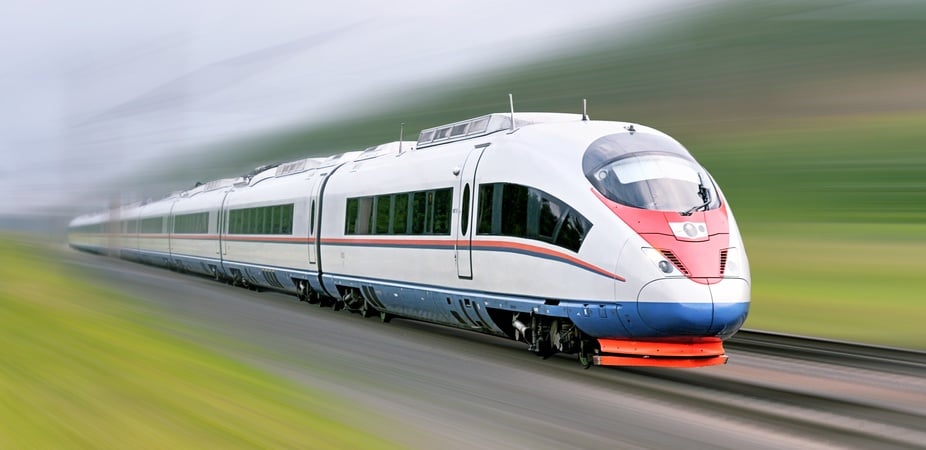
Dec 24, 2015
Blog Digital World High-Speed Rail Making Tracks in Asia
The proposed Kuala Lumpur-Singapore High-Speed Rail (HSR) is picking up speed as the first high-speed railway in Southeast Asia.
In 2013, the governments of Singapore and Malaysia agreed to build the HSR between the two countries. Last October, the land transport authorities of Malaysia and Singapore issued a request for information for the Kuala Lumpur-Singapore High-Speed Rail (HSR), for which they received 98 responses.
The project attracted interest from “companies and consortia from across the high-speed rail value chain,” including entities based in Malaysia, Singapore, the Asia-Pacific region, Europe, the Middle East and North America, reports railwaygazette.com.
WHAT IS HIGH-SPEED RAIL?
High-speed rail is a combination of all the elements, including infrastructure, rolling stock and operating conditions, according to Aneesh Kumar, BCC Research analyst.
“The infrastructure of high-speed rail is the transport network built especially for high-speed travel and especially upgraded network. The upgraded lines include connecting lines, especially at new upgraded line junctions,” he explains. “New lines are designed for speeds of above 250 km/h and upgraded lines for speeds up to 200 km/h or even up to 220 km/h.
Rolling stock represents mainly high-speed advanced-technology trains designed to travel at speeds of above 250 km/h on specially built high-speed rail lines and at around 200 km/h on specially upgraded lines.”
Dedicated High-Speed Rail. Dedicated high-speed tracks are specially designed for high-speed trains at speeds of above 250 km/h. These tracks are designed to overcome the issues with congested and some unsupportive conventional track gauge for high-speed trains.
Mixed High-Speed Rail. These rail tracks include both dedicated tracks that serve only high-speed trains and upgraded conventional tracks that serve both high-speed trains and conventional trains. The Kuala Lumpur-Singapore High-Speed Rail is an example.
Mixed Conventional High-Speed Rail. Mixed conventional high-speed rail tracks consist of both dedicated, high-speed, standard-gauge tracks that serve high-speed and conventional trains (trains equipped with a gauge-changing system), and conventional, nonstandard gauge tracks that serve only conventional trains.
Fully Mixed High-Speed Rail. Fully mixed high-speed rail tracks are compatible with all high-speed, conventional trains.
ASIA-PACIFIC MARKET FOR RAILWAY SYSTEMS ON THE MOVE
Kumar says Asia offers a huge growth opportunity for high-speed rail with the rapid expansion of the high-speed rail network, mostly driven by China and Japan and other developing regions. In fact, he says, while discussions about infrastructure and rail investments rage on in the U.S. and Europe, Asia and its countries are moving the region towards a world-leading position in high-speed rail investment.
“The high-speed rail system is affecting the airlines business, mainly in Southeast Asia,” explains Kumar. “The air transport business in China has been dominated by the HSR system, which carries about 2 million passengers per day, twice that of domestic air transport.”
According to Kumar, China’s HSR system already is first in the world in terms of speed, mileage, scale and development speed. In addition, the plans for high-speed rail by Asian regions such as Burma, Laos, Kazakhstan, North Korea, Pakistan and others are expected to accelerate in the foreseeable future. With numerous HSR projects ongoing and planned, the Asian HSR market is expected to boost the global high-speed rail market.
The high-speed rail link between Kuala Lumpur and Singapore is slated to begin its five-year construction phase in 2017.
HIGH COST AND MORE TIME
Kuala Lumpur and Singapore’s HSR was proposed in the late 1990s, but high costs initially shelved the proposal. According to Kumar, although HSR has many environmental and economic benefits, it also faces challenges in terms of financial funding, land planning, safety, capacity and growth.
“Currently, the primary benefit of the high-speed rail system is saving time, as 90% of the benefits of HSR involve the value of time saved by linking major economic hubs. High-speed rail needs huge investments and a long cycle of time for the return on investment. The estimated ROI in high-speed rail covers operating, renewal and maintenance costs but only a small share of the construction costs,” says Kumar. “As the estimated financial rate of return is about 1%, the financial burden falls on the governments; it is very difficult to attract private investment, since such investors usually require a minimum of a 15% rate of return.”
The strategic plans of several governments focus mostly on their own domestic challenges, such as public transport problems, congested roads and port access. Also, scattering construction in stages over several years due to lack of availability of funding isn’t viable, he adds.
“For example, the implementation of high-speed rail in Australia and the U.S. faces several challenges in terms of funding, economic and environmental benefits. These implementations are in the pilot phase of planning and land sourcing for routes, as steep inclines would ruin the HSR projects.”

From smartphones to satellites, antennas play a vital role in enabling the seaml...

Introduction Artificial Intelligence (AI) and the Internet of Things (IoT) are r...

We are your trusted research partner, providing actionable insights and custom consulting across life sciences, advanced materials, and technology. Allow BCC Research to nurture your smartest business decisions today, tomorrow, and beyond.
Contact UsBCC Research provides objective, unbiased measurement and assessment of market opportunities with detailed market research reports. Our experienced industry analysts assess growth opportunities, market sizing, technologies, applications, supply chains and companies with the singular goal of helping you make informed business decisions, free of noise and hype.